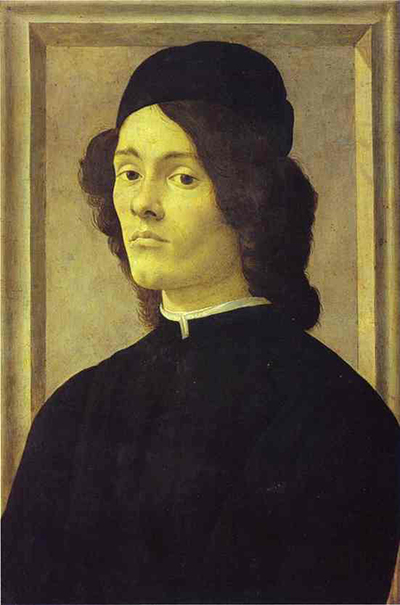The Louvre own a number of artworks which are loosely attributed to Sandro Botticelli, and they are spread out between their large museum in Paris and another in Lens. This portrait of a young man is one of those, and dates from around 1475-1500.
This artwork features a young man looks roughly in our direction, whilst positioned slightly angled away from us. Many portraits in the Early Renaissance would make use of a similar posture, but over time Botticelli would actually encourage artists to try out new formats. The young man here has long hair which reaches down to his shoulders, with a black hat on top helping to keep everything tidy. His face is attractive, with well proportioned features suggesting that the artist may have chosen him specifically for this portrait, believing him to be well suited, aesthetically. Botticelli produced a number of portraits of local Florentines as a means to perfecting his skills of portraiture, with many of these models being relatively unknown individuals who simply had the type of appearance that attracted the artist. The piece is now displayed within a highly decorative frame which considerably increases the size of this item when hung.
Research into this lesser known piece has revealed that for many years it was actually believed to have come from the career of Domenico Ghirlandaio, or at the very least from members of his studio. We do also know that a number of alterations have been made to this painting over the years, though not any recently. It is the young man's hair which seems to have received the most attention. The general concensus today appears to be that this painting was actually from Botticelli's studio, with a possibility that he himself put it together. Whilst he would collaborate with his assistants on larger projects, a simple portrait such as this is unlikely to have involved many different artists as logistically they would not have been able to work together and the amount of work involved was not that great in any case.
In terms of related artworks, Botticelli has also been linked to other paintings such as Portrait of a Young Man I, Portrait of a Young Man II, Portrait of a Young Man with Red Cap I and Portrait of a Young Man with Red Cap II. He was a true master of portraiture, but too ambitious to limit himself just to this genre. Despite being forgotten about for a number of years, he has recently been re-appraised and restored to his original status as a true master. It was down to the help of some British artists in the 19th century who encouraged historians to re-look at his work, and ever since then we have all been left wondering as to why it was even necessary for this support to be given.




